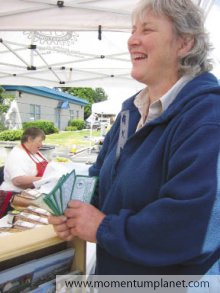Eating Local is for Everyone

Organic farmer Ann Friesen redeems a days worth of coupons at the Abbotsford Farm & Country Market
Photo: Paula Luther
Eating local is good for the consumer, the farmer, and for the Earth. Unfortunately, revisions to international trade law and national regulatory practices in the past few decades have all but crushed small family farms, the champions of the eat-local movement. The corporations that currently dominate our global food trade operate on such a large scale (e.g. two firms control about 75 per cent of the world market for cereals), they can undercut pricing on a global scale. They lobby all levels of government for continued subsidization of their petroleum-dependent growing and transportation habits. This means that an apple grown in New Zealand, sprayed with pesticides and fertilized with petroleum-based products, costs half the price of one grown organically within 100 miles of my Vancouver home. A harsher consequence of this corporation-dominated food economy is that people of low income generally find local, organic food inaccessible due to its price tag.
Food stamps were accepted at farmer’s markets across the US until the early 1990s, when a transition to electronic debit food stamp cards and the technology they entail severed the link between food stamp program participants and local farmers. However, the past decade has seen a renewed attempt to encourage lower income people – at higher risk of obesity and health problems associated with poor access to nutritious food – to consume more fresh fruits and vegetables. In 2006 New York City’s Greenmarkets teamed up with city council and introduced terminals at some of their open air markets where food stamp recipients could use their debit cards.
Michael Hurwitz, Greenmarket’s director, has watched the growth of these initiatives (16 of 46 markets had terminals in 2008 and the plan is to expand to 25 in 2009), as well as the response of the community. “We have thriving markets in lower income neighbourhoods,” he states. And programs like these are a critical support for bringing local produce to people who are clearly hungry for it. At the federal level, the USDA oversees the Farmers’ Market Nutrition Program (FMNP), a federally funded, state-administered nutrition program that provides vouchers for farmers’ market produce for nutritionally at-risk persons, although only in a supplemental capacity (no more than $30 per year, per participant).
Farmers’ markets in Canadian cities may actually be more inaccessible to people of lower income due to the fact that Canada has no federal food stamp program, and most cities rely on food bank handouts to support the nutritional needs of impoverished citizens. However, in 2007, the British Columbia Association of Farmers’ Markets – inspired by the USDA’s FMNP – launched the ground-breaking Farmers’ Market Nutrition and Coupon project (FMNCP) with funding from the provincial government. The FMNCP connects existing cooking and skill building (CSB) programs with local farmers’ markets and provides participants with coupons redeemable for a variety of fresh fare.
As it heads into 2009, the program has doubled its capacity from 2008; it has plans to work with 20 communities across British Columbia during the coming year. Paula Luther, the program’s manager, estimates that the program had a redemption rate of about 96 per cent for the distributed coupons in 2008. After the 2007 pilot program, it became clear that all parties – participating farmers, CSB managers, coupon recipients, and their families – benefited from both the increase of connection with their community and the sense of mutual support.
Children in these families have front-row seats as their parents shop at the markets and come home to prepare nutritious meals from local produce. Luther relates watching a parent give her child a coupon and allow him to make a choice for what food he would like to bring home.
Imagine for a moment, the typical experience of a child in a supermarket, grabbing at brightly coloured boxes of processed, sugary, artificially coloured and flavoured products. Now imagine that same child walking among stalls laden with fresh, colourful local produce and reaching up with delight to take hold of a bright orange and white striped squash, or a shining red apple.
The BCFMA allocated $165,000 for coupons in 2008. When compared to the market share of the multinational agri-businesses, programs like these are a tiny sliver of the economic pie. And yet the fact that these relatively few dollars benefit the most vulnerable members of the community while supporting sustainable, local agriculture is the magic that Luther hopes will enchant community after community.
When asked how this sliver might grow to become a mainstream economic force, Luther points back to the community level. Volunteer at your local market. Sit on a board of directors. Offer your skills at a local community kitchen. She urges people to “Step outside and get to know your neighbours, share a garden, have some mason bees, plant a tree!” Head out to your local farmers’ market, imagine what it could be like if everyone in your community could participate, and, as Luther advises, “If you don’t see what you want, then you get to create it.”
http://www.momentumplanet.com/food/eating-local-everyone




No comments:
Post a Comment